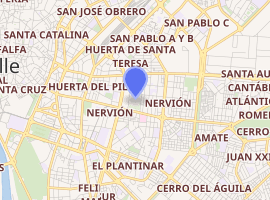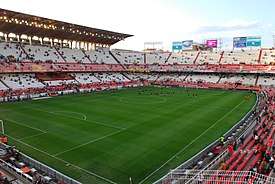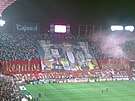Ramón Sánchez Pizjuán Stadium
The Ramón Sánchez Pizjuán Stadium (Spanish: Estadio Ramón Sánchez Pizjuán; [esˈtaðjo raˈmon ˈsantʃeθ piθˈxwan]) is a football stadium in Seville, Spain. It is the home stadium of Sevilla Fútbol Club, and is named after the club's former president, Ramón Sánchez Pizjuán, who served Sevilla for seventeen years in the early 20th century and helped pioneer the building of the ground.[2] It was the venue for the 1986 European Cup Final between Steaua București and Barcelona and the 1982 World Cup semi-final game between Germany and France.
Nervión | |
 | |

| |
| Location | Seville, Andalusia, Spain |
|---|---|
| Coordinates | 37.3840°N 5.9705°W |
| Owner | Sevilla FC |
| Operator | Sevilla FC |
| Capacity | 43,883[1] |
| Field size | 105 m × 68 m (344 ft × 223 ft) |
| Surface | Grass |
| Construction | |
| Built | 1955 |
| Opened | 7 September 1958 |
| Renovated | 1996, 2017 |
| Architect | James Cox / Manuel Muñoz Monasterio |
| Tenants | |
| Sevilla FC (1958–present) Spain national football team (selected matches) | |
With a capacity of 42,714 seats, Ramón Sánchez Pizjuán is the ninth-largest stadium in Spain and the third-largest in Andalusia.
Historical background
Ramón Sánchez Pizjuán was opened in 1958 as an all-stand stadium with a capacity of 70,329 spectators, replacing the Estadio de Nervión.Its capacity was reduced to 68,110 for the 1982 FIFA World Cup. It was further reduced to its current capacity of 42,714 seats when it was refurbished and transformed into an all-seater stadium during the mid 1990s.
The stadium is nicknamed "La Bombonera" (pronounced [la βomboˈneɾa]; more commonly used to refer to Estadio Alberto J. Armando, the home stadium of Boca Juniors) or "La Bombonera de Nervión" [la βomboˈneɾa ðe neɾˈβjon] due to the Nervión neighbourhood where the stadium is situated.
This stadium contains a singular legend: the Spanish national team has never lost a game against an international team in this stadium. In European competition, Sevilla has lost only five times at home; to AZ Alkmaar in the 2006–07 UEFA Cup, to CSKA Moscow in the 2009–10 UEFA Champions League, to Real Betis in the 2013–14 UEFA Europa League , to Manchester City in the 2015–16 UEFA Champions League and to Bayern Munich in the 2017–18 UEFA Champions League.
In May 2018, the club announced launching an expansion project for the stadium that will eventually increase its seating capacity up to 47,000.[3]
1982 FIFA World Cup
The stadium was one of the venues of the 1982 FIFA World Cup, and held the following matches:
| Date | Team #1 | Res. | Team #2 | Round | Attendance |
|---|---|---|---|---|---|
| 14 June 1982 | 2–1 | Group stage | 68,000 | ||
| 8 July 1982 | 3–3 (5–4 p) | Semi-finals | 70,000 |
Gallery
References
- "Sevilla Fútbol Club - La entidad". Sevilla FC. Retrieved 10 April 2016.
- "Ten things you may not know about the Ramón Sánchez-Pizjuán". La Liga. 21 July 2015. Retrieved 21 August 2018.
- Expansion east stand now underway
External links
| Wikimedia Commons has media related to Estadio Ramón Sánchez Pizjuán. |
- The Stadium Guide
- Virtual Tour.
- Estadios de España (in English)
- Ramón Sánchez Pizjuán Virtual Tour at FootballStadiums360
| Preceded by Heysel Stadium Brussels |
European Cup Final venue 1986 |
Succeeded by Praterstadion Vienna |
| Preceded by Stadion Energa Gdańsk Gdańsk |
UEFA Europa League Final venue 2022 |
Succeeded by Puskás Aréna Budapest |




